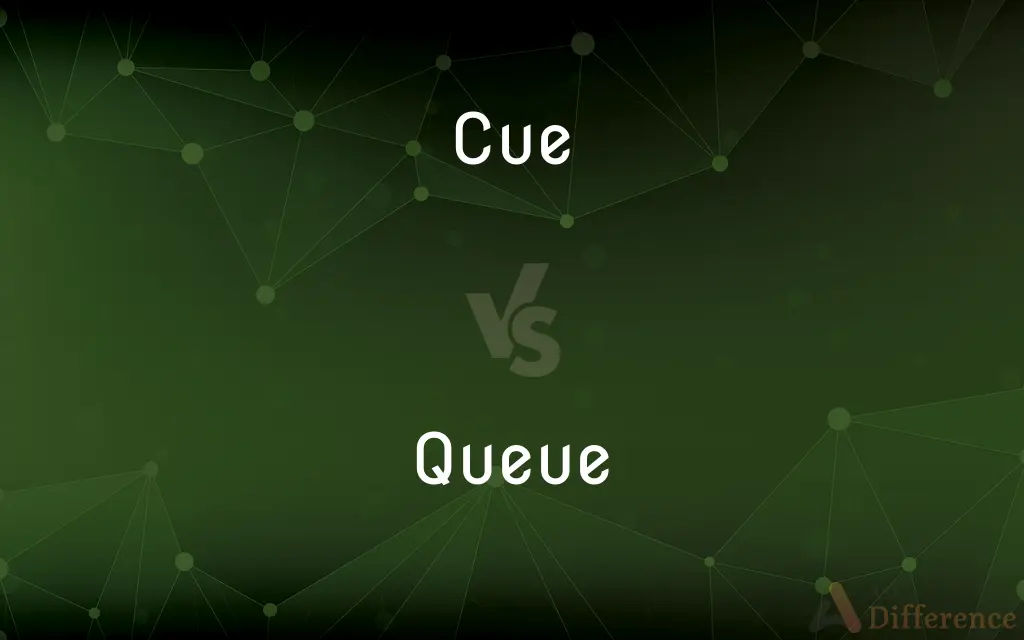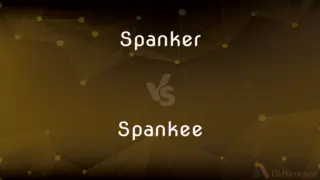Cue vs. Queue — What's the Difference?
Edited by Tayyaba Rehman — By Fiza Rafique — Updated on September 26, 2023
Cue is a signal or prompt that indicates when to start or do something, often used in performance or communication. Queue is a line or sequence of people or things waiting for their turn, typically in an orderly fashion.

Difference Between Cue and Queue
Table of Contents
ADVERTISEMENT
Key Differences
Cue: A prompt or signal, often used in performance, communication, or as a hint. Queue: A line or ordered sequence of people, vehicles, or items waiting for their turn.
Cue: Utilized in contexts where timing, signaling, or prompting is essential, such as theater, sports, or conversation. Queue: Refers to a physical or virtual line where people or items wait, like in queues at stores or digital queues on websites.
Cue: "The director gave the actor a cue to enter the stage." Queue: "There was a long queue of customers waiting at the checkout."
Compare with Definitions
Cue
A signal or prompt to initiate an action.
The ringing of the bell served as a cue for the actors to start their performance.
Queue
An ordered line of people or items waiting for their turn.
The queue at the amusement park moved steadily as visitors waited for rides.
ADVERTISEMENT
Cue
A visual or auditory prompt in a presentation.
The slide transition served as a cue for the audience to focus on the next topic.
Queue
A digital waiting system, such as online ticket queues.
The virtual queue for concert tickets allowed fans to secure their seats.
Cue
An assistive tool in learning or memorization.
Flashcards are often used as cues to recall important information.
Queue
To line up in an orderly fashion.
The students were instructed to queue up outside the classroom.
Cue
A long tapered stick with a leather tip used to strike the cue ball in billiards and pool.
Queue
To join a line or wait in turn.
Shoppers queued at the store entrance before the Black Friday sale.
Cue
A long stick with a concave attachment at one end for shoving disks in shuffleboard.
Queue
A line or sequence of people or vehicles awaiting their turn to be attended to or to proceed.
Cue
(Nonstandard) Variant of queue.
Queue
A list of data items, commands, etc., stored so as to be retrievable in a definite order, usually the order of insertion.
Cue
A signal, such as a word or action, used to prompt another event in a performance, such as an actor's speech or entrance, a change in lighting, or a sound effect.
Queue
A plait of hair worn at the back.
Cue
A reminder or prompting.
Queue
Take one's place in a queue
In the war they had queued for food
Cue
A hint or suggestion.
Queue
Arrange in a queue
Input or output requests to a file are queued by the operating system
Cue
An extract from the music for another part printed, usually in smaller notes, within a performer's part as a signal to enter after a long rest.
Queue
A line of waiting people or vehicles.
Cue
A gesture by a conductor signaling the entrance of a performer or part.
Queue
A sequence of stored data or programs awaiting processing.
Cue
(Psychology) A stimulus, either consciously or unconsciously perceived, that elicits or signals a type of behavior.
Queue
A data structure from which the first item that can be retrieved is the one stored earliest.
Cue
(Archaic) One's assigned role or function.
Queue
A long braid of hair worn hanging down the back of the neck; a pigtail.
Cue
(Archaic) A mood; a disposition.
Queue
To get in line
Queue up at the box office.
Cue
The letter q.
Queue
To place in a sequence
Queued the queries in order of relevance.
Cue
(Games) To strike (a ball) with a cue.
Queue
To braid or twist (hair) into a queue.
Cue
(Nonstandard) Variant of queue.
Queue
A line of people, vehicles or other objects, in which one at the front end is dealt with first, the one behind is dealt with next, and so on, and which newcomers join at the opposite end (the back).
Cue
To give a cue to; signal or prompt.
Queue
A waiting list or other means of organizing people or objects into a first-come-first-served order.
Cue
To insert into the sequence of a performance
Cued the lights for the monologue scene.
Queue
(computing) A data structure in which objects are added to one end, called the tail, and removed from the other, called the head (in the case of a FIFO queue). The term can also refer to a LIFO queue or stack where these ends coincide.
Cue
To position (an audio or video recording) in readiness for playing
Cue up a record on the turntable.
Queue
(heraldry) An animal's tail.
Cue
A small portion of bread or beer; the quantity bought with a farthing or half farthing and noted with a q (for farthing) in the buttery books.
Queue
A men's hairstyle with a braid or ponytail at the back of the head, such as that worn by men in Imperial China.
Cue
An action or event that is a signal for somebody to do something.
Queue
(intransitive) To put oneself or itself at the end of a waiting line.
Cue
The last words of a play actor's speech, serving as an intimation for the next actor to speak; any word or words which serve to remind an actor to speak or to do something; a catchword.
Queue
(intransitive) To arrange themselves into a physical waiting queue.
Cue
A marker or signal that triggers something, such as the start of an audio recording.
Queue
To add to a queue data structure.
Cue
A hint or intimation.
Queue
To fasten the hair into a queue.
Cue
(obsolete) Humour; temper of mind.
Queue
A tail-like appendage of hair; a pigtail.
Cue
A straight tapering stick used to hit the balls in various games.
Queue
To fasten, as hair, in a queue.
Cue
(obsolete) The tail; the end of a thing; especially, a tail-like twist of hair worn at the back of the head; a queue.
Queue
A line of people or vehicles waiting for something
Cue
To give someone a cue signal.
Cue the cameraman, and action!
Queue
(information processing) an ordered list of tasks to be performed or messages to be transmitted
Cue
To spark or provoke.
Queue
A braid of hair at the back of the head
Cue
To take aim on the cue ball with the cue and hit it.
Queue
Form a queue, form a line, stand in line;
Customers lined up in front of the store
Cue
To form into a cue; to braid; to twist.
Queue
A sequence of data awaiting processing.
Data packets form a queue before transmission over the network.
Cue
The tail; the end of a thing; especially, a tail-like twist of hair worn at the back of the head; a queue.
Cue
The last words of a play actor's speech, serving as an intimation for the next succeeding player to speak; any word or words which serve to remind a player to speak or to do something; a catchword.
When my cue comes, call me, and I will answer.
Cue
A hint or intimation.
Give them [the servants] their cue to attend in two lines as he leaves the house.
Cue
The part one has to perform in, or as in, a play.
Were it my cueto fight, I should have known itWithout a prompter.
Cue
Humor; temper of mind.
Cue
A straight tapering rod used to impel the balls in playing billiards.
Cue
A small portion of bread or beer; the quantity bought with a farthing or half farthing.
Hast thou wornGowns in the university, tossed logic,Sucked philosophy, eat cues?
Cue
To form into a cue; to braid; to twist.
Cue
An actor's line that immediately precedes and serves as a reminder for some action or speech
Cue
Evidence that helps to solve a problem
Cue
A stimulus that provides information about what to do
Cue
Sports implement consisting of a tapering rod used to strike a cue ball in pool or billiards
Cue
Assist (somebody acting or reciting) by suggesting the next words of something forgotten or imperfectly learned
Cue
A hint or indication that guides behavior.
His raised eyebrow was a subtle cue that he disagreed with the proposal.
Cue
A reference point for memory or recognition.
The scent of fresh flowers was a cue for her to reminisce about her childhood.
Common Curiosities
Can a cue be both visual and auditory?
Yes, cues can take various forms, including gestures, spoken words, signals, or visual aids, depending on the context.
Where is the term "cue" commonly used?
"Cue" is frequently used in theater, film, music, and communication contexts to signal actions, prompts, or responses.
What is a cue?
A cue is a signal, prompt, or indication used to initiate an action, provide guidance, or mark a point in time.
How does a cue differ from a hint?
A cue is a more deliberate and explicit prompt, while a hint is often more subtle and indirect.
What are digital queues, and where are they used?
Digital queues are virtual waiting systems, often employed in online ticket sales, customer support, and virtual events.
Is body language an example of non-verbal cues?
Yes, body language, such as gestures and facial expressions, is a form of non-verbal cues used for communication.
Why are queues important in customer service?
Queues help maintain order and fairness, ensuring that individuals are served in the order they arrive.
How is queue management important in businesses?
Efficient queue management can enhance customer satisfaction, reduce wait times, and streamline operations in retail, hospitality, and service industries.
What is a queue in the context of waiting lines?
A queue refers to an ordered line or sequence of people, vehicles, or items waiting for their turn, commonly seen in various everyday situations.
Can queues be found in non-physical settings?
Yes, queues can exist in both physical and virtual environments, such as waiting in line at a store or in an online shopping cart.
Share Your Discovery

Previous Comparison
Gully vs. Gutter
Next Comparison
Spanker vs. SpankeeAuthor Spotlight
Written by
Fiza RafiqueFiza Rafique is a skilled content writer at AskDifference.com, where she meticulously refines and enhances written pieces. Drawing from her vast editorial expertise, Fiza ensures clarity, accuracy, and precision in every article. Passionate about language, she continually seeks to elevate the quality of content for readers worldwide.
Edited by
Tayyaba RehmanTayyaba Rehman is a distinguished writer, currently serving as a primary contributor to askdifference.com. As a researcher in semantics and etymology, Tayyaba's passion for the complexity of languages and their distinctions has found a perfect home on the platform. Tayyaba delves into the intricacies of language, distinguishing between commonly confused words and phrases, thereby providing clarity for readers worldwide.
















































